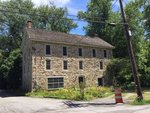

Amy Hollamder, very much a 21st-century woman, lives in a wool mill built in the early 19th century and wants to share her passion for the past with everyone.
“I’m a storyteller,” the historian said. “I want to show a whole landscape so people can see what it was like to live back then.”
It was her work and influence that created many of the interactive exhibits at the National Museum of Industrial History (NMIH) in Bethlehem. Amy was the museum’s first president and CEO.
She now is self-employed as an exhibit designer and a strategic planner for museums, guiding them through this century’s challenges.
She admits there is something special about an old stone mill that has always held a kind of enchantment for her. “I have a love of mills,” she confessed and said as a child she’d often go to Grovers Mill which was just down the road from her New Jersey home. “I loved being there, loved the sound of the water. It just had a calming effect,” she said.
Extraordinary, considering it had been Grovers Mill that Orson Welles selected as the first Martian landing site in his 1938 radio broadcast, “The War of the Worlds.” But that was way before she was born, and no Martians ever showed up when she was there.
Still, that girlish love lingered and when Amy considered where she wanted to live, she said, “It just had to be in a mill.” She and her husband, Doug Milne, who also has a museum background, found their mill in 1999 in the tiny village of Finesville in New Jersey, just across the Delaware River from Riegelsville. Milne, who shares his wife’s passion for historic preservation, is associated with the National Canal Museum in Easton. An amateur actor who often portrays historical figures, he also captains the canal boat there.
Their home is a handsome structure built around 1812 with a wide lawn sweeping down to the Musconetcong River, whose waters racing to join the Delaware River once turned the mill’s waterwheel. They’ve made that patch of land with its ancient trees into a magical place with a stone circle and a labyrinth. It’s the perfect setting for a couple so involved in bringing history to life.
The mill was originally the Fines Wool Manufactory, where, for about 50 years, wool was spun, carded and woven into blankets, Amy said. Later it housed a tool factory, a blacksmith shop, a wheelwright shop, a fraternal lodge and a residence.
When they bought it, though, it was “a bit run down with stucco falling off in sheets,” Amy said. They had the handsome fieldstone walls repointed, replaced the metal roof with period-appropriate cedar shingles and installed reproduction windows. A metal dragon sculpture greets visitors outside the front door.
The mill is one of a cluster of sturdy fieldstone buildings. The millrace has been filled in but the mill is close enough to the river for residents to hear the water rushing past and to see colorful kayaks passing.
Amy has been involved in the world of museums since her graduation from Vassar College. She majored in art history there and earned a master’s in historic preservation and conservation from the University of Pennsylvania. She worked at first in art museums but has now moved toward historic projects. From the beginning of her career she had not been content with the lack of a deeper education for museum-goers.
For her, it was not enough to just identify and date an object with a plaque on a wall. She wanted museum-goers to “get a sense of community, what it was like to live back then.” For example, at the NMIH she believed it was not enough to just show the bobbin boxes little boys were forced to carry all day long. She arranged to have a loaded box there so a child could pick it up and understand what child labor had been like.
She also believes, “Children are becoming more and more disconnected,” and considers “engaging a new generation” of prime importance.
Amy is now a strategic consultant for the Delaware and Lehigh National Heritage Corridor. She also manages two historic properties, the Erwin-Stover House and the Stover-Myers Mill for the Bucks County Parks and Recreation Commission and she founded the Tinicum Players who present a series of special programs at the Erwin Stover House where costumed performers help those attending immerse themselves in the past—to get more than a glimpse of what it was really like.
Join our readers whose generous donations are making it possible for you to read our news coverage. Help keep local journalism alive and our community strong. Donate today.